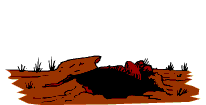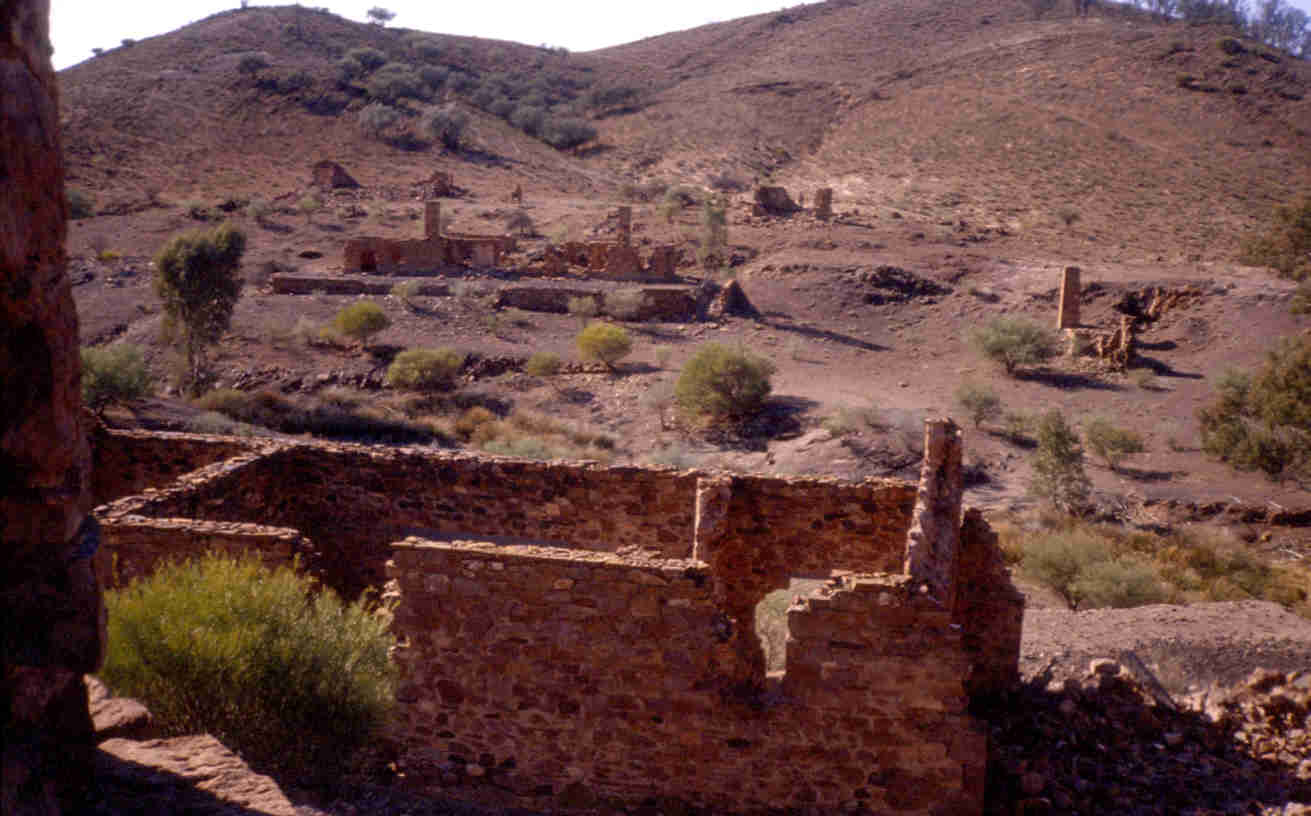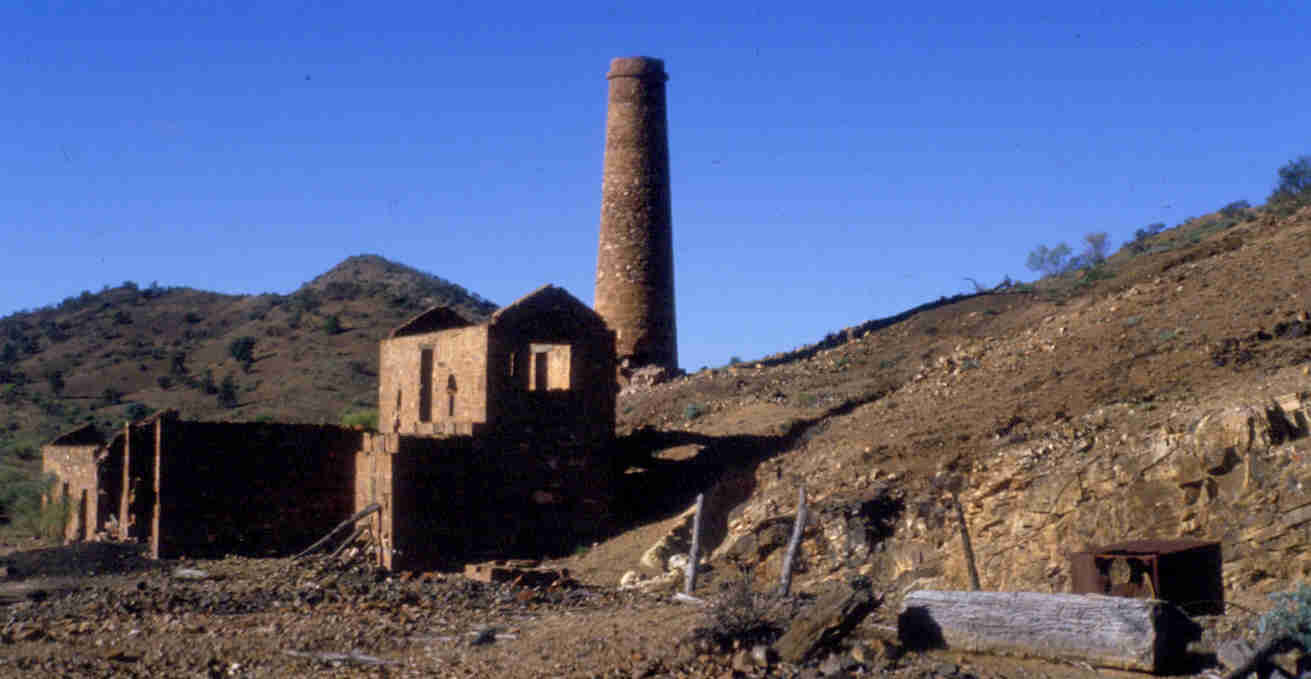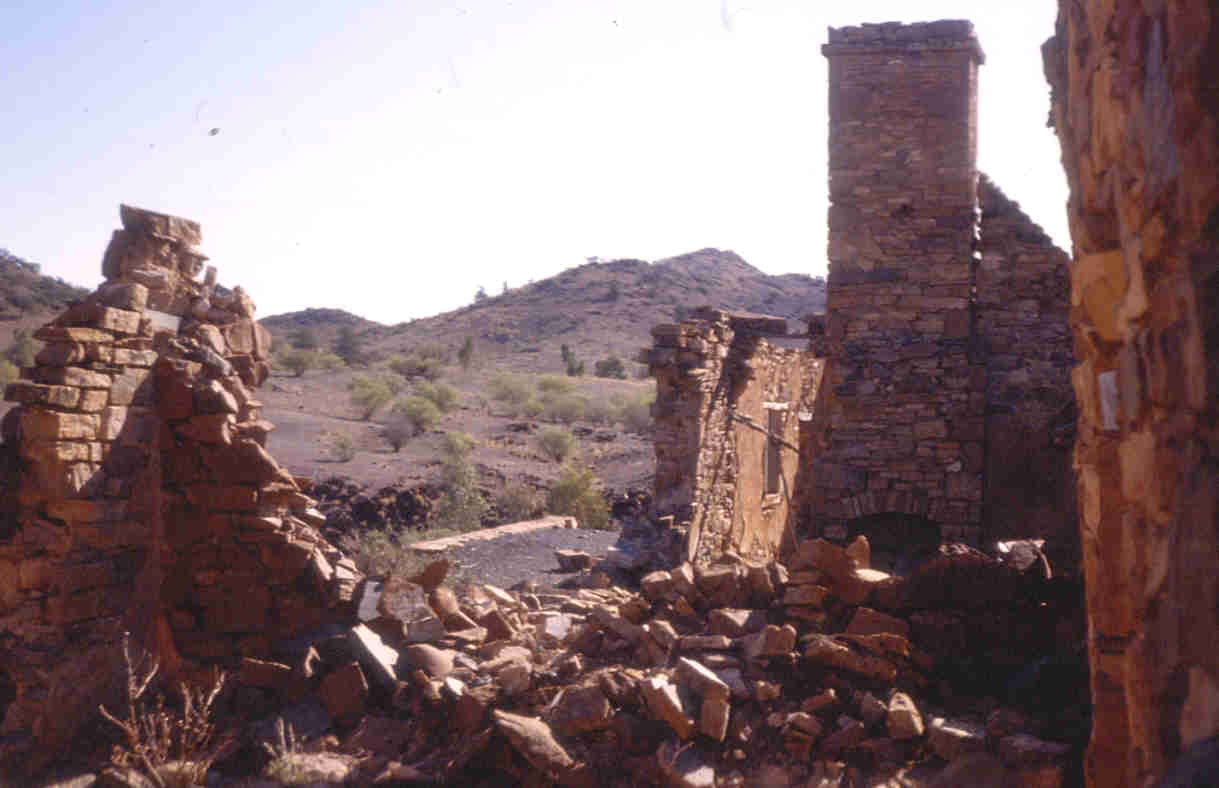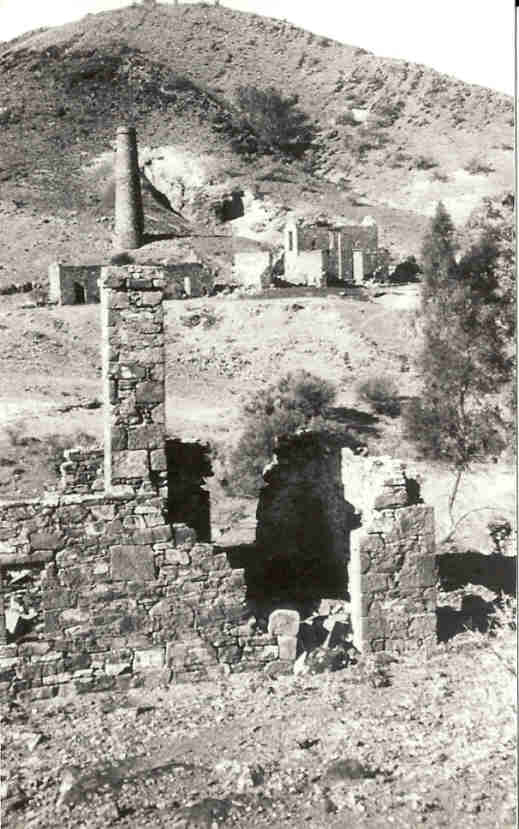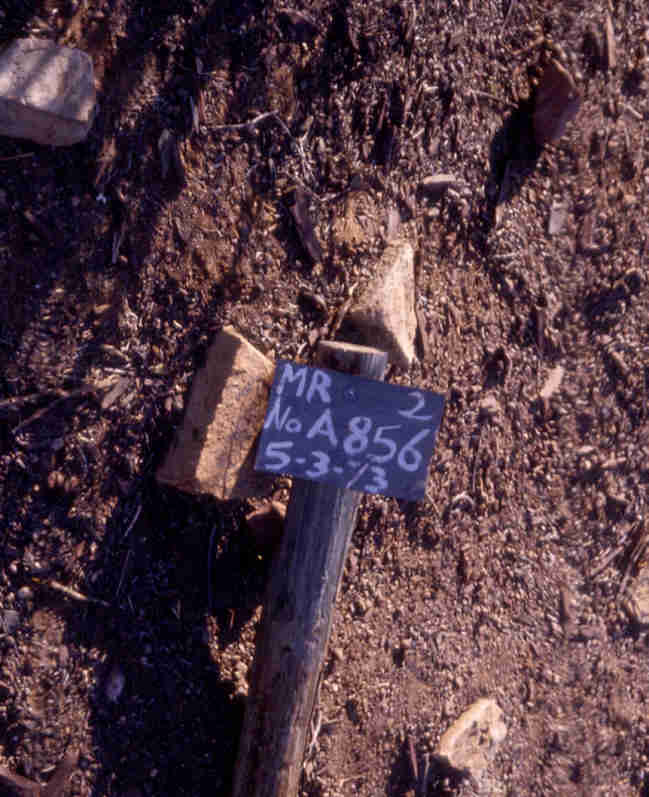


|
Nuccaleena.Part 3
Occasionally John Parker Buttfield of Blinman paid the town a visit in his capacity as Sub-protector of Aborigines or to marry people as he was still a Reverend, JP and Special Magistrate. On 12 November 1866 he travelled to Nuccaleena to marry William Carruthers, son of George Carruthers of Scotland and Sarah Ann, third daughter of Z Faulkner of Buckinghamshire, England. Section 105 was put up for sale in March 1866 but there were still some people who just could not believe that it was all over. Captain Tonkin was still at the mine in July 1867. On 18 September 1867 Charles Hacket, storekeeper of Port Augusta, applied for mineral lease no. 2,721, of eighty acres near Nuccaleena. He too found that there was no copper and forfeited his claim on 18 December. On 31 October 1867 another mineral lease, no. 1,805, also near Nuccaleena was put up for sale by auction at the Lands Office in Adelaide. Early 1868 the Warren Brothers partnership was dissolved by mutual consent and Pearce Rogers Warren would take on the Nuccaleena store on his own.
However, RA Fiveash, agent for the Warreuta Copper Mining Company of South Australia, Ltd., was quite prepared to request the Commissioner of Crown Lands in 1869 to transfer leases no. 275, 276, 277, 278, 279 and 280, which that company had acquired from William Smallpiece Whitington and Israel Simmons, to the Warreuta Company. These leases had originally been taken up in March 1863. More than 700 had been spent on developing this mine and 116 for buildings and machinery. Only forty tons of copper ore which raised 240 had been sold. Later that year it seemed that all hope of reopening the Nuccaleena mine had been given up, as the buildings and machinery were advertised in the Adelaide newspapers to be sold by auction. The mine engine was removed in 1871 to Blinman to be used in that mine. At the township of Nuccaleena the few remaining miners and settlers did not always live in harmony. On 11 May 1868 Police Trooper Curnow arrested William Perkins for stealing 6, a coat and a book from Michael Marra. All property was recovered and Perkins discharged. Three months later Police Trooper Porter arrested Henry Pellett who had stolen 4.4.0 from Jos. Turner. Again the money was recovered and Pellett discharged. In November 1868 Hugh Mattheson died at the Bushman Inn. As late as June 1879 William Sheedy was taken in custody for stealing a horse at Nuccaleena, belonging to John Murphy of Quorn. A much more serious matter occurred on 4 March 1869, when William Cox died of "drink administered at The Bushman Inn, still kept by Charles Faulkner. An inquest was held by Henry Charles Swan SM. Evidence was given by William Carruthers and his wife Sarah Anne, Samuel Terrell, John Snell, James Spencer, the barman, and Theodore Johan Carl Hantke, later known as Theodore John Charles Hantke. The verdict stated that his death was caused by the consumption of an excessive amount of alcohol. Meanwhile in London the annual shareholders meeting was held to discuss the state of affairs of the Great Northern Cooper Company. They were told that as yet no profitable discovery had been made at their mines and all work had been stopped. Worse still was the fact that there was not enough money to pay outstanding bills. It was then that it was decided to wind up the company voluntarily. The Company was wound up on 1 March 1869 and finally dissolved on 17 December 1880 when it ordered that "all the books, papers and documents ... be destroyed by being cut, torn or otherwise separated into fragments so as to render the same useless as a means of information." Lease 105 was sold on 20 July 1869, together with the buildings and improvements, for 550. It was resold on 24 September for 100. At Nuccaleena Charles Faulkner definitely had problems too and not only with his customers. In June 1869 he sued his wife Elizabeth for adultery and wanted a divorce. Thomas Moran, publican of Melrose admitted having had intercourse with her but according to Elizabeth it was against her will and more in the nature of an assault. Charles and Elizabeth were married on 6 March 1853 but had no children and while living at Nuccaleena Elizabeth was frequently drunk. After a lengthy court case the marriage was declared Null and Void on the ground of impotency.
A year later William Carruthers, a small shareholder in the Sliding Rock mine, carpenter and one-time hawker, held the licence of the Bushman's Inn. Charles Faulkner had moved to Blinman, building his second hotel. On 12 December 1870 Carruthers transferred the publican's licence to Michael Francis Lennon, who held it until 1873. Another death occurred on 16 October 1872, when William M Kekwick "was seized with a severe illness, which ended fatally." Kekwick had arrived in South Australia on 17 April 1840 on the Warrior from London. After having worked at Burra and the Victorian goldfields he moved to the Northern Flinders Ranges. Here he was introduced, by his brother, to James Chambers who employed him to assist John McDouall Stuart with survey work. In 1862 he was second in command when Stuart finally successfully crossed the continent from South to North.
Kekwick's death caused great hardship for his wife and four children. After the inquest form was signed by Dr Andreas Vonnida, JP, his body was taken to the Blinman cemetery. The burial service was conducted by the local schoolmaster, W Richards and attended by Gosse, leader of the Government Exploring Expedition of which Kekwick had been third in command. Some of the others who were present included Dr Vonnida, Police Trooper Porter and T Young, clerk of the Local Court. His wife later moved to Western Australia. During 1872 Professor Ulrich was instructed by the South Australian government to examine some of the mines in the Northern Flinders Ranges. After having closely inspected the Nuccaleena mine, he was strongly convinced that the ore-deposit was a true lode and that the mine had been given up too hastily. He suggested that the mine should be given another trial. His report stated that the mine was situated about eight miles from the Oratunga Mine, in a steep rangy part of the country, close to Blackfellow's Creek. The open workings indicate that the ore-deposit is a true lode. The underlay of this lode was near the surface but, judging from the position of the main working shaft, must apparently have changed to steep southward in depth. Its thickness near the surface seems also to have been very variable, as the open workings range from three to ten feet in width, and large pockets of rich ore were apparently found in the northern wall. Neither the latter, nor the southern wall are well defined near the surface, and the bounding strata seem generally much distorted, and small irregular, rolls are also perceptible in the outcrops of the beds on the flanks of the neighbouring hills, south west of the workings. The rocks near the lode, in depth, consist of hard blackish, thick bedded, calcareous slate, as shown by spoil-heap round engine shaft, but are at the surface yellowish white, rather soft and full of veins and small patches of brown iron ore and green copper stains. The main workings extend about five to six chains up the steep hill to a point where the lode apparently died out, a narrow level starting a little higher up hill and driven some distance in the former line of strike of the lode, showing no evidence of the continuation of the lode fissure. The rocks passed through by this level consist of soft arenaceous slates, mottled white and yellow and traversed by veins of brown iron ore.
About half way between the level and the top of the hill there is a large rugged outcrop of highly cavernous mammillary brown iron ore, and numerous veins of the same ore, dipping flat northward, are observable on the surface towards the hill top. At the lower boundary of the massive outcrop, a shaft has been sunk in the line of the main workings, which seems also to have been unsuccessful in striking the lode again; the ferruginous slates penetrated show, however, scattered green stains and coatings as indications of copper ore. As regards the nature of the metallic and other minerals occurring in the lode, the examination of a large heap of ore, left on the dressing floor; gave the following results (as no doubt derived from above the water level ore); ochreous gossan, enclosing massive patches and druses of acicular crystals of atacamite (cloride of copper), generally associated with some malachite and chrysocolla (silicate of copper); patches of tile ore, less abundantly small veins and patches of cuprite (red oxide of copper), and more rarely still, specks of native copper. Mammillary brown iron ore, and calcite appear frequently in irregular cavities. From below the water level massive, coarsely crystalline spathic iron, full of specks, patches, and seams of copper pyrites, associated with a little iron pyrites (similar to the ore of the Oratunga Mine), quartz, crystallized and in thin veins; occasionally white calcite, imperfectly crystallized, in druse cavities. A piece of dense white heavy spar, found near the lower workings would also indicate the occurrence of this mineral in that portion of the mine. About twenty chains eastward, round the base of the hill which the lode traverses, a roomy tunnel-now partially fallen in-has been driven from near the bottom of a gully in the direction of the top of the hill. The strata penetrated consist of alternating white, yellowish, and brownish red, flaggy slates, in part concretionary and quartz ore, and much stained and veined with brown iron ore. At the mouth of the tunnel, and for some distance in, they are very friable, full of dendritic markings, and contain scattered cavities, coated with calcite. Judging from a heap of ore left on grass, of fair quality, and composed of the same minerals as those just enumerated from above the water-level of the main workings, this tunnel must have struck the continuation, or perhaps, a new make of the lode - a fact which would indicate that the latter, though of rather short extent on the surface, lengthens considerably in depth. Considering this, in connexion with the otherwise very favourable character of the lode, more especially as regards quantity of ore and nature of associated minerals, I am of opinion that the mine has rather too hastily been given up, and deserves another trial in depth; for the running out of the lode in dip, which, it is said, led to the desertion, is most probably only a local contraction, or may, perhaps, be due to a fault, and the search was conducted in the wrong direction. A number of well-built houses on the ground, still in pretty good repair; apparently a good supply of water for ore dressing, besides other conveniences, would greatly lessen the expense of any new undertaking. Maybe this report on the Nuccaleena and other mines in the neighbourhood had inspired renewed confidence, for on 8 November 1872 a mineral application (no. 4,091) for 80 acres near Nuccaleena was made by Doig, Glass and Brooks. These three gentlemen were no strangers to mining matters. All of them had taken out mineral claims long before this one. Peter Doig, a blacksmith by trade and previously from Burra, had applied on 21 September 1866 for claim number 2,720 at Ketchowla, on the Eastern Plains. The other two men had made claims near Blinman at various times. It was not until April 1875 though, that some interest was shown again in the old Nuccaleena mine itself. Arthur Harvey held a mineral right to search, but had not paid for the improvements. According to him, their value had been set too high by Goyder and he would not take up the mine unless they were reduced. They were not, and consequently very little work was done on or in the mine.
On 23 November 1880 the Corporation of South Australian Copper Mines Ltd. was formed in London with a capital of 250,000. This company on advice of their directors, Lord Headly, JH De Ricci, William Baxter, Thomas Adair Masey, Patrick Carnegy and Jacob L Montefiore, decided to start mining in a grand manner in the Northern Flinders Ranges. They bought many of the previously worked and now abandoned mines. Amongst these were the Yudanamutana, Vocovocanna, Mount Rose, Moolooloo, Sliding Rock, John Bull, Kirwan, Wirrawilka, Warrioota and the Nuccaleena. By 1884 more than 107,000 shares of 1 each had been sold but almost no copper had been raised. A year later the company went into liquidation and the properties sold to the South Australian Mining and Smelting Company Ltd. When silver mania had taken hold in the north during the 1880s many mineral claims were taken out. Even during the very hot month of January 1888 several mineral claims were approved around the Nuccaleena mine, including one by Jane Glass. Other claims approved were those made by G Glass, GE Glass, WA Tennant, W Gaston, A Tennant, WN Ferguson, A Gaston, FT James, D McFarlane, W Cummings, L James and J Crimp. A week later, GH Smith's claim near Nuccaleena was also approved. Numerous other claims were either applied for or approved during the early months of 1888. Most of these properties were situated in the Northern Flinders Ranges. Silver mania continued where copper mania had left off. Unfortunately very little eventuated at Nuccaleena during all this renewed activity. Occasionally the mine was inspected by the government and at times it even produced a little copper. During March 1898 a few miners from Beltana were busy at Nuccaleena, while a year later Lennon and Timbers were working the mine for a short time with favourable results. Two tons of ore had been dispatched which yielded 25% copper. Another two tons were still at the mine awaiting transport and were expected to yield between 30-40% copper. Early in 1900 three tons of 29% ore were at grass, making a total of 33 tons raised in 8 months by a couple of men. In addition to raising copper ore a lot of dead work was done. A clearance had been made to a depth of 16 ft and a splendid show of ore exposed about 9 ft high and 6 ft wide. The owners believed that this would go down to the water level where it had already been proved that sulphide ore exists. That same year a good lode of copper was struck, averaging 45% and the property offered to a Broken Hill syndicate. In 1902 the Inspector of Mines paid a visit to the mine and was informed that very little work had been done, except to break out some ore left exposed in the old workings. Recently the underground timbers had been burnt, resulting in cave-ins. However one old adit had been cleaned out and about ten tons of ore gathered. In 1906 the Nuccaleena mine became the property of the Tasmanian Copper Company. On 27 February 1907, the Advertiser published an article on Passing Reflections, which included some interesting details about the Nuccaleena and its two cemeteries, as well as the problems faced by the Tasmanian Copper Company. Midway between Blinman and that other old-time copper mine, the Sliding Rock, but somewhat to the north-east of the track, is situated another great monument to early, English enterprise, the Nuccaleena mine. In a somewhat isolated locality, away from the railway and off the beaten track of even pastoral traffic, this long-deserted and generally weird spot has escaped much of the notice lavished by travellers and historians on other early mining ventures of the north. One cannot but consider the epithet "weird" peculiarly applicable to old Nuccaleena, whether the feeling of regret at the change and decay in all around be aroused by a hurried inspection of the last resting places of the dead, or by a view of the ruined habitations of man and beast, or of the ruined creations of man's early engineering enterprise. One can read the life history of the mine by gazing on its dead from the small but unduly crowded cemetery which belonged to the mine in the bend of the creek's bank, with its tale of dysentery and of victims who succumbed to the mineral-impregnated waters of the creek to that other cemetery which accommodated the township's dead, away on the flat at no great distance from the ruins of the old hotel. What strong waters effected in one instance, stronger waters compassed in the other, if local traditions are to be credited. To the sceptical additional evidence can be found in support of tradition in the ruins of a room attached to that old hotel, the walls of which were built of bottles. A glance around the dump will satisfy most folk that however much occasional fossickers may have overhauled the surface workings, handpicked, dressed and dispatched ore therefrom, of late years the residue is sufficiently immense and correspondingly rich to justify the work of reorganisation which the Tasmanian Copper Company has but recently initiated. What the lower workings may reveal, and what constitutes the nature of these workings, belongs to the future. With the timbers of the main shaft destroyed by fire, which is usually in the case of old mines, the result of malice aforethought and with no assistance from any reliable plans, the mining work ahead of this company will be worse than that of breaking fresh ground. It is when dealing with underground problems such as this that the neglect of compulsory registration of all mines and their workings in the office of the State's Department of Mines is so much to be deplored. It is poor consolation to prospective development work to be dependent upon the memory of the oldest inhabitant who worked in the mine as a lad. Imagination too often plays the part of describing winzes and drives which subsequent exploration proves to be non-existent. If the same class of tradition, which places the percentage of all ore which was removed to the seaboard by this English company at over 50% is to be relied upon, then the inner contents of this vast dump should prove even more refreshing to the finances of the Tasmanian Copper Company than was that at the Blinman. Among those who in the past fossicked around the Nuccaleena dump, bagged and dispatched ore therefrom, more than one has of late been aroused to realise that refractory looking sulphide material which was discarded as useless, and rejected by them as of no account, is more rich in copper contents and of more intrinsic value than the best of carbonates so laboriously selected and sent away. The proceedings of the new proprietary will probably intensify this feeling of chagrin, for it is the presence of this sulphide ore which has especially commended the proposition. Of all good bargains made by Mr CM Henrie in the north, none give promise of panning out better than this old mine, and, as is frequently the case, the actual purchase consideration borders on the infinitesimal. During 1907 about 127 of copper was extracted. On 5 October 1907 all miners working for the Tasmanian Copper Company were paid-off and all work was stopped on the different mines, including the Nuccaleena. Unfortunately it was not just the miners who lost their jobs and income. Business at Nuccaleena, Blinman, Yudanamutana and other centres were also hard hit. Most of the miners, especially those with families, eventually left and moved south. After the Tasmanian Company had admitted defeat as well, the Hunter Brothers in 1914, with government assistance, gave the mine another try. They installed a shaft with a ten metre head gear, a twelve horse-power winding winch and two steel wire ropes with rope-guides from the top of the headgear down to the bottom of the ten metre shaft. They also put a vertical boiler in place and used two 50 gallon iron kibbles for ore-hauling. After several payments from the government, amounting to 565, everything was working well by 1915, and during 1919 the mine was still in operation.
In January 1921 it was reported that Joseph Satterley/Sutlev, an old prospector was working the abandoned dumps and had been doing that for a number of years. However on 23 November 1922 he was found dead in his hut at Nuccaleena and buried at the mines cemetery. Very little transpired after that. Occasionally, and as late as 1973, a prospector, or mining company, would take out a search licence but that is as far as it went. In 1962 the Government officially declared the town of Nuccaleena "to cease to exist" and its roads to be closed. All that remains today are the Cornish chimney, ruins of the mine and miners' cottages, horizontal and vertical shafts and a cemetery with one lonely tombstone, placed there by Alice Fry to mark the site where her 48 year old husband Anson was buried after he died on 21 May 1862 at Springhill near Kooringa.
*** If you would like to find out more,
|
